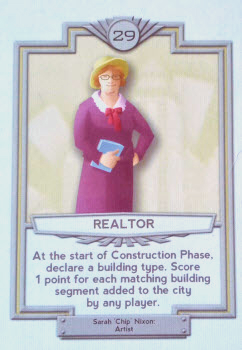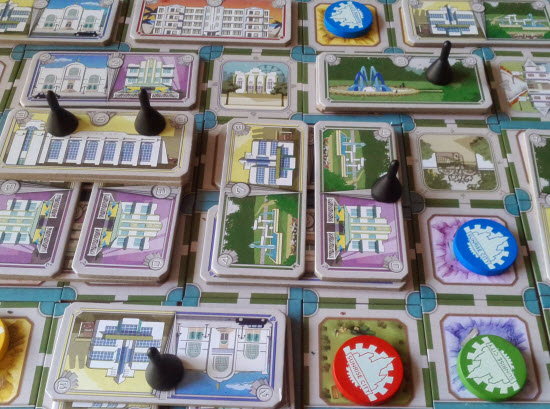“Sir? Yes, thank you sir. Yes, I’d love to help you with your application, but we have to ensure everything is in order. Do you happen to have your Intent to Process Media Materials?
Wonderful, and two copies of the Cookie Consumption Waiver?
Splendid. Lastly, do you have your permit to Disseminate Intellectual Property?
Perfect. Everything is in order, sir. Please allow a short four to six weeks for your application to take effect. Next!”
The Premise
The people of Sunrise City have big plans for the expansion of their fair municipality, but to achieve their lofty goals they are going to need help. City planning isn’t an easy job, and they don’t have a lot of experience with large-scale projects such as this. There’s a lot of prestige (and money) to be made, attracting all sort of talent and forcing players to compete over who will have the biggest impact on the city.
The Rules
Sunrise City is a tile-laying game where players build up both the city’s prominence and their own. The game consists mostly of two randomized tile types: Zones and Buildings. To begin, players also receive six bidding tokens and four Role cards.
Role cards both provide players with a special ability and determine the turn order each round. Players select three Role cards in a draft-style format, where one Role is chosen from their hand of cards and then rest are passed to the next player.
Rounds in Sunrise City take place over four phases: Preparation, Zoning, Bidding, and Construction. In Preparation, each player first receives four Zone tiles and four Building tiles. Then, players select and reveal simultaneously which Role card they will use.
Next is Zoning, where players expand the city’s footprint by placing Zone tiles. Zones come in five types: Residential (Red), Commercial (Blue), Industrial (Yellow), Parks (Green), and Mixed-Use (Purple). Zone tiles are placed adjacent to existing Zones, and if they share a type, it scores the player points. However, the sides of Zones are either sidewalks or waterways, and at least one side must always be sidewalk-to-sidewalk.
After all tiles are placed, players enter Bidding. Here, players use their bid tokens on the Zone tiles. Players may either place a bid token on an unclaimed Zone or on top of another player’s bid, although if a player gets a second token on their existing bid, that Zone is locked out from further bidding. Once all bids are placed, the player with the top-most token of each location is the winner.
Lastly comes Construction. In it, players place Building tiles on empty Zones or on existing Buildings. Building tiles take up two Zones and come in the same five colors as Zones. To place a Building, the color of the tiles underneath must match. Purple tiles are wild, though, and may support any color. Placing a Building on empty Zones creates the first floor. This requires that the player have a bid token on at least one of the two Zones and that it is not built across water.
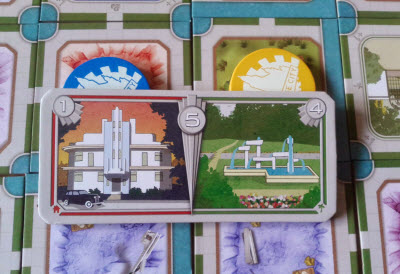
Blue builds this tile, netting 6 points: 5 for the tile and 1 for the first floor bonus. Yellow also receives 4 points.
Constructing a Building awards the player points equal to the tile’s center number. Each odd-numbered floor also awards bonus points. On the first floor, any player whose bid token was built on receives the points in the tile’s corner. Every other odd-numbered floor awards bonus points based on the Building’s height. (For example, the third floor gives one bonus point and the fifth gives two.) Any Building placed adjacent to one of the special Community Zone tiles matching its color also awards bonus points.
For every ten points scored, the player receives a Benchmark (star) token. However, any time they reach a score of exactly ten points, they receive two Benchmarks instead. Consider it a performance bonus.
After all Buildings are placed, the round ends. After three rounds, the game end. The player with the most Benchmarks has proven to be the most adept real estate mogul of the bunch and is declared the winner.
Everyone else will be relegated to running a run-down motel on the outskirts of town.
Hands-On Construction

Let’s get building.
Some games draw people in with an interesting narrative. Others appeal to their problem-solving nature. With Sunrise City, it aims to bring out your inner the Lego builder. Sunrise City is first and foremost a civ-building affair, where the game’s theme and the means to get across the finish line are tied up in a symbiotic mix of building codes and city planning. And it portrays this particularly well.
One of the major entertainment factors to Sunrise City is that each time you play you are building the city from the ground up, and every playthrough creates a unique layout. Will you have a city full of single-floor buildings that sprawl along the table, or will players decide to centralize their efforts, creating ten-story buildings in one area while leaving others largely undeveloped? Either are possible, and depending on the Roles and tiles involved, both could lead to winning strategies. For tile-laying games, this randomness is essential to a game’s longevity, and Sunrise City has a fair amount of randomness without ever feeling very luck-based.
Yet while it’s delightful to see what the final result will look like each time, the physical act of laying the tile and stacking Buildings takes that civ appreciation to the next level. Sunrise City embodies that same feeling you got every time you created something out of Lincoln Logs that actually didn’t immediately fall over.
This is due in large part to the quality of the game’s materials. All of the components are impressively durable, from the wooden Benchmark tokens to the various tiles themselves. The tiles – particularly the Building tiles – are surprisingly thick and sturdy, and while they will still fray slightly after long-term usage, they hold up well to repeated use.
In fact, we’re pretty sure with enough Building tiles you may be able to construct actual building. You know, so long as it doesn’t rain…
Sunrise City never feels flimsy or cheap while playing, and it will easily stand up to many playthroughs. Architects are bound to appreciate this, as this is their type of light building game.
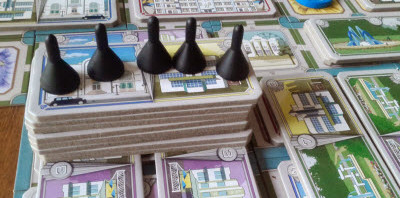
Sunrise City’s first skyscraper.
In addition to providing some physical heft to the game, all of these pieces reward you with a fantastic tactile and visceral experience. Even the game’s Floor markers – put on buildings to remind players of the next level’s bonus points – have a visual role to play. That is, besides being a practical reminder for scoring, they also double as flavorful spires or towers atop the buildings as they grow.
Working off The Blueprints
While the game’s towering physical qualities are one of the its best attributes, the artwork is a little more down to earth. Indeed, the artwork in Sunrise City is serviceable for the game’s purposes, depicting the colors and types of buildings that each zone is known for. But it isn’t terribly eye-catching either. It gets the job done but isn’t terribly awe inspiring. You know, sort of like actual city planning.
The Art Deco themed buildings are more interesting when viewed from a completed cityscape than on individual tiles (where they often feel repetitive), and it’s only from a more panoramic view where they pop out of the board a bit. Most people will end up focusing more on the tile’s colors than the pictures anyhow, so this facet won’t have any bearing on the quality of the game’s worthiness. Immersionists will take notice though, and unfortunately they likely will see Sunrise City as a missed opportunity for some creative depth. They will not be impressed with the lack of worldbuilding in the game.
Fluctuating Business Models
Sunrise City is a largely straightforward affair, centered around accumulating as many points as possible over three rounds. From the clarity of the rulebook to the simple color-coded tile system, you can pick up the gist of the game with little effort. Sunrise City even goes so far as to try to minimize game complexity with such features as the Role cards lasting just one round and only including a handful of the non-standard Community Zone tiles.
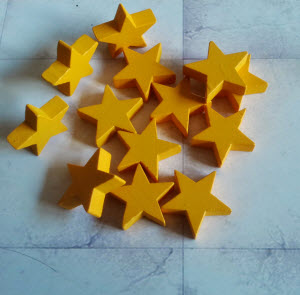
You get a star! And you get a star!
On the one hand, this makes the game incredibly accessible for new players. Between its ease of learning and hourish play time, Sunrise City makes for a decent family game or a lightweight strategy game. There are viable choices to be made throughout the three rounds, from which Roles to choose to which Zones to bid on, but the game flows through each phase like a canal through the downtown districts.
Most Socializers will file the necessary paperwork to play this game. Its quick ruleset, moderate play time, and (generally) quick turns are all marks in their favor. As with most tile placement games, however, there easily can also be small bouts of downtime as players figure out what their next best move is.
The most complicated part is actually the scoring itself, and even that is just a matter of keeping track of bonus points. Beyond merely trying to place tiles for points, the deepest strategy to the game lies in trying to ensure that you can reach exactly 10 points for the double Benchmark tokens. You may place a Building tile in a less than optimal position, for instance, and take fewer up-front points in order to reach that magical 10. Victory goes to those with the most Benchmarks, and acquiring extra Benchmark tokens is by far the most effective way of accomplishing that. It’s just good business.
On the other hand, this style of game will have its detractors. Tacticians will have a hard time remaining interested in Sunrise City, for one, as although each playthrough provides slight variations on strategy, it doesn’t have the kind of long-term planning this group thrives on. You can really only plan for the current round at best in this game, and even then much of that hinges on the actions of others.
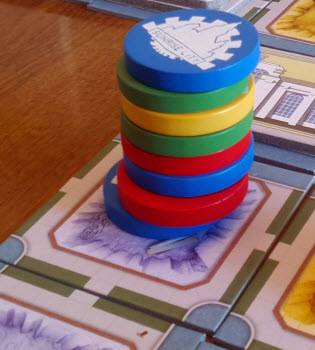
This bidding may have gotten a tad excessive…
That being the case, there also isn’t much in the way of risk-taking in Sunrise City – even though one of the phases is, ironically, all about bidding. There is a clear path to winning, and it requires making logical investments. Daredevils are not cut out for the world of ordinary city planning.
Strikers will have similar issues. Sunrise City is for 2-4 players, although it tends to work best with three or four as it provides more player engagement. Having additional players also means there is some indirect room for you to interfere with one another, whether it’s the result of outbidding on a particular Zone tile or putting a Building on the spot someone else wanted.
However, the game still rewards you far more for playing your own tiles than trying to block someone else, and those actions don’t pay out to a large degree. For an pseudo-economic game, there isn’t much cutthroat behavior in Sunrise City, and while many will laud that fact, Strikers will likely pass on this game.
The Takeaway
Sunrise City proves to be a very solid game, both physically and mechanically. So dig in. Sunrise City is a true Gateway Plus Game – and one with a robust amount of replayability. The game is substantive enough for those seeking light strategy and light enough for those who worry about games that get bogged down in substance. Plus, its tile-stacking mechanic is as engaging as it is charming to look at. Sunrise City succeeds at not being a dry affair, keeping players involved while still being accessible for a wide spectrum of players and remaining easy to understand. For those looking to build up their collection with a sturdy post-Gateway Game, Sunrise City easily makes for a good cornerstone choice.
Sunrise City is a product of Game Salute.
Cardboard Republic Snapshot Scoring (Based on scale of 5):
Artwork: 3
Rules Clarity: 4.5
Replay Value: 4
Physical Quality: 4.5
Overall Score: 4
Photo Credits: Lego man by Wikia; Lincoln Logs by Nation Parks Service.

